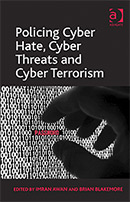Policing Cyber Hate, Cyber Threats and Cyber Terrorism
 Authors : Imran Awan and Brian Blakemore, eds.
Authors : Imran Awan and Brian Blakemore, eds.
Publisher: Farnham, Surrey, UK; Burlington, VT: Ashgate, 2012. 201p.
Reviewer: Anita Lavorgna | November 2012
In the last decade, the importance of cyberspace has become increasingly evident: this new arena offers unprecedented access to information, and consequently has proved to be a useful tool for sharing ideas and facilitating commerce. At the same time, criminal and terrorist organizations have also understood its potential and taken advantage of the new opportunities offered by information and communication technologies for carrying out their activities. As a consequence, cyberspace has become a new battlefield in which new national and international security challenges have to be faced.
Providing an overview of new security threats in cyberspace is a challenging task.
Policing Cyber Hate, Cyber Threats and Cyber Terrorism carries out this task successfully. Indeed, the book effectively takes into consideration the analytic challenges posed by the peculiar nature of cyberspace while maintaining a thorough attention to possible operational responses to foster cyber security, with a preference for preventive and intelligence-led approaches. While in the last few years both scholarly and popular attention has been increasingly directed toward the neighbor research field of cyber crime, this analytical and informative volume focuses on certain aspects in the realm of cyberspace security that have been sometimes neglected, in particular cyber terrorism and hate on-line. In this way, this book provides a valuable and timely introduction to current debates about cyber threats that jeopardize physical and online security.
Policing Cyber Hate, Cyber Threats and Cyber Terrorism is an edited book consisting of ten chapters and an introduction. Suggestions for further readings are provided at the end of each chapter. A first group of contributions (chapters 1 to 5) deals with the conceptualization of cyber threats, cyber terrorism and cyber hate, by presenting empirical examples as well as by lingering on theoretical debates. This first set of chapters certainly raises interesting points, especially thanks to its interdisciplinary approach. Unfortunately, the structure of this first part is not very cohesive and the terminology used is sometimes misleading: the book could have benefited from a more clear explanation of the reasons why certain cyber threats have been considered while others have not. Similarly, a more explicit distinction among the working definitions of cyber-crime, cyber threat, cyber terrorism, and cyber hate would have been less confusing for the reader. The major contribution of the volume is probably offered by the second set of chapters (chapters 6 to 10), which constructively addresses cyber security strategies and in particular the policing of cyber terrorism by providing some directions for both long term solutions and short term changes. In particular, this second group of contributions emphasizes the need for more effective, flexible and coordinated approaches in countering threats in cyberspace in order to find a proper balance between human rights and the demand for security.
Most contributions focus on the British context. However, given the intrinsic transnationality of cyberspace and the global significance of the issues discussed, the arguments presented in those essays could be easily extended to other countries. Moreover, most chapters do consider several countries in their empirical examples, as well as in their descriptions of the legal and institutional context, with a particular attention to the international dimension. Below follows a short presentation of each chapter. I focus in particular on the second part of the book.
The first two contributions provide the key to interpreting the book. In the first chapter, Brian Blakemore introduces some of the main themes that are covered in the rest of the volume, such as certain problems in policing criminal activities committed via the Internet, the lack of a clear reporting of cyber crimes to the police, and the importance of informal social control in cyberspace. In particular, by using several concrete examples, Blakemore effectively illustrates some of the new dangers and challenges affecting cyberspace.
In chapter 2, Imran Awan addresses definitional issues, focusing on cyber threats and cyber terrorism. He presents two main approaches in defining cyber-terrorism and discusses them in a complete and critical way, suggesting the adoption of the wider definition in order to better counter this threat in all its aspects.
Chapters 3 and 4 discuss in more detail the nature of terrorist organizations: in particular, Jane Prince focuses on psychological aspects of cyber hate and cyber terrorism, stressing the difficulties of psychological research in dealing with these issues. Brian Blakemore, on the other hand, addresses terrorist cults in order to investigate their modus operandi in recruiting and converting people to their cause.
In chapter 5, Geoff Coliandris explores the complexities of hate crime in cyberspace and advocates the need for flexible multidimensional strategies in order to regulate and police cyber hate in a more effective way, according to the principles of problem-oriented policing (POP).
Moving to the second part of the volume, chapter 6 offers a valuable analysis of the policing of cyber terrorism and extremism, supplying an interesting insight into the challenges to the police in the new realm of cyberspace and a glimpse of the extent to which cyber attacks are likely to reshape the balance between freedom and security. In his essay, Imran Awan examines several responses to the threat of cyber terrorism at the international and at the national level, considering both laws and their implementation.
In chapter 7, James Gravelle stresses how the role of new technologies is enabling terrorist groups to improve their propaganda as well as their operational capacities. To deal with these changes, in the last few years security services have started to modify their tactical approaches. However, in spite of this, police forces are not always successful in meeting their goals. Gravelle focuses in particular on the knowledge-management implementation (i.e., the creation, share and use of knowledge in a coordinated way by organizations and individuals involved), whose efficiency could be enhanced by creating knowledge communities so to improve the sharing of knowledge among individuals and among partner agencies and consequently task prioritization and resource allocation.
Chapter 8 is another interesting piece on the use of intelligence-led policing. On the one hand, since national boundaries are more blurred in cyberspace and criminals and terrorists operating via the Internet take advantage of this situation, policing thus has to improve the ability to operate transnationally: as underlined by Colin Rogers (p. 129), “the rise of transnational policy is echoed in the growth of information policing function, including regulating the flow of information nationally and internationally”. On the other hand, criminal and terrorist groups all have a community basis and consequently there is the pressing need to engage with “communities at grass-roots level in order to provide information and intelligence for multilevel use.” By examining some of the government response to cyber terrorism employed in England and Wales for intelligence gathering and application, Rogers underlines the points of strength and weakness in the current model. In particular, he stresses the importance of establishing trust with local communities and of evaluating and disseminating intelligence at all levels in order to respond to global threats.
Chapter 9 by Tim Read deals with the way in which issues of cyber security have been addressed in existing policy guidance both in the UK and at the international level, providing an exhaustive and updated description of the strategies to counter cyber threats. The author here focuses on the definitions of cyber crime provided in official documents and on the responses there suggested, underlying common themes – such as the need for a global approach and for a partnership between the private and public sectors – as well as major difficulties in the implementation of coordinated responses.
In the last chapter, Awan and Blakemore critically retrace some of the main themes covered in the book. As they sum up, even if austerity measures have been taken as regards resources to enhance security because of the global financial crisis, “it is only by understanding the intelligence cycle, how information is gathered and disseminated, whilst continuing to engage with communities at all levels, that an effective response can be formulated to global problems” (p. 189). Indeed, the root-causes of cyber terrorism and cyber hate have to be resolved if we ever want to eradicate them.
The explicit aim of the book is “to bring together a diverse range of multidisciplinary ideas to explore the extent of cyber hate, cyber threat and cyber terrorism” (1). And in fact, this book has brought together scholars and practitioners with expertise in different areas, ranging from criminal justice to psychology. This has allowed for a synthesized overview of the major theoretical and empirical issues with respect to cyberspace research, discussing them in an interdisciplinary and balanced way. Overall, Policing Cyber Hate, Cyber Threats and Cyber Terrorism provides a valuable and opportune contribution to the growing literature on cyber threats by analyzing topical issues from different but complementary angles. Despite the complexity of the subject matter, this book has the merit of offering useful insights not only for academics working on related topics, but also for practitioners and other readers with an interest in current trends in criminology, security studies, social policy, and Internet law.
Anita Lavorgna, PhD student, School of International Studies, University of Trento (Italy).


